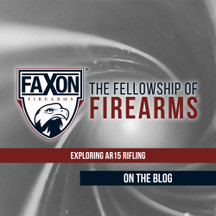Posted by Faxon Firearms Staff on Oct 9th 2023
Exploring AR15 Rifling
Exploring AR15 Rifling
The AR-15 rifle has earned its place as one of the most versatile and popular firearms in the United States since its development in the 1950’s. Among its many features, the rifling inside the barrel stands out as a crucial element that contributes to its accuracy and performance. In this article, we delve into the world of AR-15 rifling to understand how it works and why it matters.
What is Rifling?
Rifling is the process of imparting spiral grooves inside the barrel of a firearm. For the AR-15, this spiral pattern serves the essential purpose of imparting a spin to the bullet as it travels down the barrel. This spin stabilizes the bullet in flight, ensuring greater accuracy and a longer effective range. There are multiple ways to put rifling into a barrel, generally, one of 3 methods is used.
- Button Rifling: A hardened steel button with the inverse of the desired rifling pattern is pulled through a barrel blank. This displaces the material of the barrel blank into the rifling pattern.
- Cut Rifling: Involves cutting the rifling grooves directly into the barrel material with precision machining tools. The cutting tool gradually carves out the grooves as it moves along the barrel.
- Cold Hammer Forging: A mandrel with the inverse of the desired rifling pattern is inserted into the barrel blank. The barrel blank and mandrel are then subjected to a series of high-impact hammer blows, which deform the barrel's inner surface around the mandrel.
Faxon Firearms specializes in button rifling and has the capability of producing cut rifled barrels.
Twist Rate: The Key to Stability
One of the critical factors that define AR-15 rifling is the twist rate, expressed as a ratio (e.g., 1:7 or 1:8). This ratio indicates the distance the rifling takes to complete one full rotation (e.g., 1 full rotation every 7 inches or 1 full rotation every 8 inches). In an AR-15, twist rates typically range from 1:7 to 1:12, with 1:7 and 1:8 being the most common.
- 1:7 Twist: A 1:7 twist rate means the rifling completes one full rotation in 7 inches of barrel length. This faster twist rate is well-suited for stabilizing heavier and longer bullets.
- 1:8 Twist: A 1:8 twist rate is a versatile option that can stabilize a wide range of bullet weights effectively.
- 1:12 Twist: A 1:12 twist rate is often used for lightweight bullets and is known for its accuracy at shorter distances.
- Other Twist Rates: In special cases, there are some cartridges that perform better with a more specialized twist rate. Faster twists such as 1:5 can often be seen in use with cartridges such as 300 Blackout in shorter barrel lengths using heavy subsonic projectiles.
Choosing the right twist rate for your AR-15 depends on the type and caliber of ammunition you plan to use. Heavier bullets generally perform better with a faster twist rate to achieve stability, while lighter bullets may work better with a slower twist rate. This is not always the case, but this is a good rule of thumb to follow.
The Benefits of Proper Rifling
- Improved Accuracy: The spin imparted by rifling helps to keep the bullet on a consistent trajectory, reducing the chances of tumbling or veering off course.
- Extended Effective Range: Rifling allows AR-15 rifles to maintain accuracy and velocity over longer distances, making them suitable for both close-quarters combat and precision shooting at extended ranges.
- Enhanced Terminal Performance: Stabilized bullets penetrate more effectively and transfer their energy efficiently upon impact, making them more lethal and reliable.
AR-15 Rifling and Barrel Length
It's worth noting that the length of the barrel also plays a role in the performance of AR-15 rifles. Longer barrels tend to provide higher muzzle velocities, which can affect the bullet's trajectory. The correct rifling and ammunition, combined with the appropriate barrel length, contributes to the overall performance and versatility of the AR-15 platform.
Conclusion
In the world of firearms, the AR-15 is celebrated for its accuracy and adaptability. A crucial element of this precision is the rifling inside its barrel. Understanding the importance of twist rates and how they influence bullet stability is key to maximizing the potential of your AR-15.
Whether you're using your AR-15 for target shooting, hunting, or self-defense, the rifling inside the barrel is a fundamental component that should not be overlooked. Properly matched ammunition and rifling ensure that your AR-15 performs with the accuracy and reliability it is known for.
Investing time in understanding your AR-15's rifling can lead to improved shooting experiences, tighter groups, and increased confidence in your firearm. So, the next time you pick up your AR-15, remember that the art of precision begins with the rifling in its barrel.


